The sail is set up for only 5° of weather helm and set up with a wide enough groove to accommodate steering for conditions or to accommodate very gusty/shifty conditions.
Once hiking conditions present themselves, a balanced boat with appropriate rig setup for the conditions become particularly important to maximize your hiking efforts into productive speed.
The first objective whether flat water, waves, gusty or steady, is to have just a small amount of weather helm. That is, the rudder is doing a minimum of work and is not creating significant drag to travel in a straight line. As wind speeds increase and more power is pushed into the sail, the center of effort is pushed aft. When this happens, sail draft moves aft of the underwater central pivot point (center of lateral resistance) and wants to turn the boat upwind. This is known as “weather helm”. As the wind gets stronger and stronger this force typically becomes worse unless action is taken - a boat with a lot of helms is known as “unbalanced”. We would need to use a lot of rudder pull just to keep it going straight, creating excessive drag. This tends to makes hiking harder and it’s also tiring on the arms.
More cunningham promotes a bit of twist up top to keep the power low where it belongs, reducing leverage on you, making hiking easier… and it reduces weather helm as the draft is moved forward.
Aim to have about 5° of weather helm. This means your tiller will be up “just a bit” from the centerline to keep your boat moving straight. It hardly requires any effort to keep it there. But we don’t eliminate it completely - if you let go of your tiller, the boat will still want to round up into the wind. In waves, it can be a bit harder to get right - even with a good setup, each time you slam into a wave, your apparent wind moves back - if you aren’t accommodating for that somehow, you’ll feel added weather helm and steer up. Slam into a few in a row without steering down and you end up pinching, even when your laser sail setup is good - this illustrates the importance of good steering in combination with good sail setup.
Get an edge with our Laser Performance Clinics
In waves, think about setting up to balance yourself inside the steering groove - if you bear away and get super wound up, and it’s hard to drive the boat down the wave backs, there’s probably too much helm. Conversely, if the boat doesn’t want to come back to your average desired angle after you steer down, you may not have enough - you want to feel SOME loading up to bring you back and the helm shouldn’t feel too “mushy”.
There are multiple ways to laser sail setup for 5° of weather helm, with varying amounts of vang/cunningham for each - your conditions will dictate which to choose.
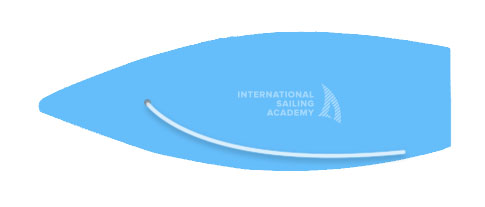
The tiller is up too much and the rudder drag is high. Too much weather helm.
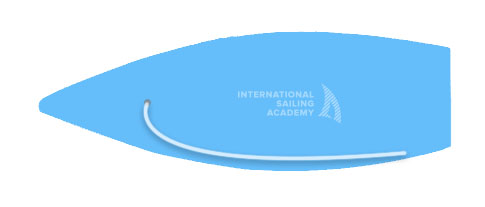
The tiller is just up a bit from the centreline and the boat is balanced.
Since we don’t require a great deal of absorption/tolerance in the rig, set up a little more optimally/critically than when in waves or very gusty/shifty conditions. Use a bit of cunningham to keep the draft reasonably positioned and vang as needed to reduce camber/rig loads and maintain a nice angle of heel. With a finer entry angle and flatter sail, the AOA will be more critical - and the best tool to keep up with a changing AOA is sheeting rather than steering, so generally, be more active with the sheet when the sail is flatter. This is a fast, efficient, low drag setup.
Very shifty/gusty conditions or presence of waves call for a more automatic/forgiving rig. A wider groove. We’ll be steering more and want to maintain good flow over the sail as frequently as possible during these angle changes.
Cunningham is our primary tool to attain these objectives. More cunningham promotes a bit of twist-up top to keep the power low where it belongs, reducing leverage on you, making hiking easier… and it reduces weather helm as the draft is moved forward. A tighter cunningham also increases your entry angle as the draft moves forward. This shape allows attachment over a larger range of AOA adjustments made through steering and/or sheeting. So we use more cunningham first to laser sail setup for waves or very gusty/shifty conditions. Even in wind strengths that require just a bit of hiking, world-class sailors apply some cunningham to keep the entry round - they compromise a bit of power to achieve this and use less vang.
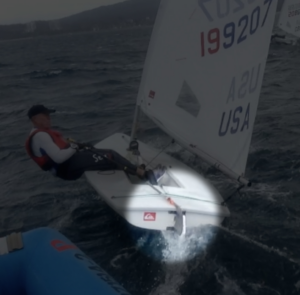
This draft position shows an efficient narrow entry and a less forgiving luff to steer to.
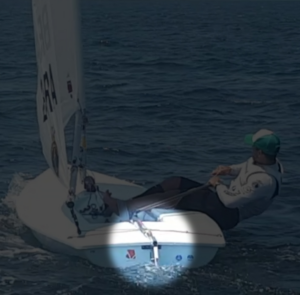
A more critical entry angle is efficient for stable wind conditions & flat water.
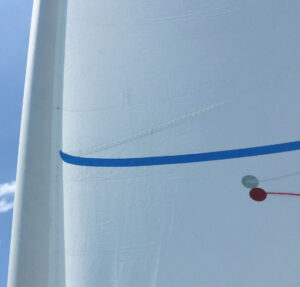
Here we can see more luff tension has been added. The draft has been pulled forward increasing entry angle.
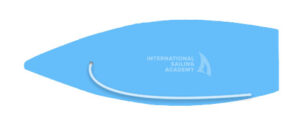
Larger entry angle is more forgiving to angle of attack changes and less prone to stalling.
The outhaul is used to reduce drag and flatten out the leech exit. Keep the sail looking relatively even from top to bottom and apply outhaul as necessary alongside the other controls to do this. Note, the tighter the outhaul gets, the more critical the rig becomes, so be mindful of that before strapping it too tightly.
With a balanced boat and appropriate rig setup for the conditions, you’ll be able to sail the boat a lot faster and more easily.
Lastly, we apply vang as necessary. As the power increases in the sail, we need a way to keep our weather helm and rig loads under control. We do this through camber reduction and sheeting, so we add more vang tension. Unfortunately, the flattening effect actually narrows our entry and makes the rig less forgiving again (flatter), but it has reduced rig loads and given us the ability to sheet out effectively, which we absolutely need as the wind gets stronger - so we are compromising/prioritizing. Generally be more active with the sheet when using a lot of vangs, because the now flatter setup cannot maintain good flow over such a wide steering range or in erratic/gusty conditions automatically.
With a balanced boat and appropriate rig setup for the conditions, you’ll be able to sail the boat a lot faster and more easily. Experiment with these shapes on your own and see if you notice a difference in feel and performance in your next session.
For customized on-water coaching, including video review and technical briefings on laser sail setup and other techniques, sign up for one of our 2016-17 Laser Speed Week or Custom Clinics today.
This article is part of a four-part series on sailing faster with less hiking. Don't miss part 1 on steering and part 3 on gust and lull management.